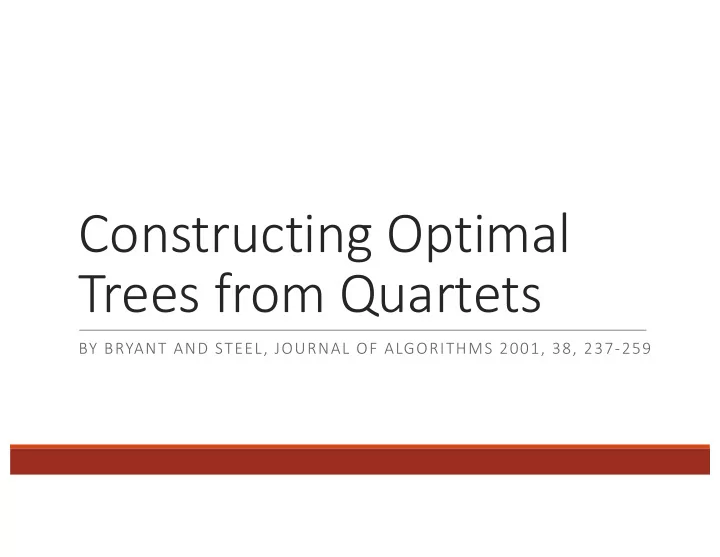

Constructing Optimal Trees from Quartets BY BRYANT AND STEEL, JOURNAL OF ALGORITHMS 2001, 38, 237-259
General Problem • How to best construct a large phylogenetic tree from a set of smaller subtrees • Having a collection of subtrees is common • Computational Complexity • Biological and Statistical Advantages • Finding a phylogenetic tree that agrees with the largest number of quartets is NP-Hard ? SPRING 2017 CS 581 CLASS DISCUSSION
Split Constrained Quartet Optimization Problem • Input: • Weighting w for quartets on leaf set L • Set S of allowed splits (i.e. bipartitions) of L • Parameter: • Degree bound d • Output: • Return a tree T with vertex degree bounded by d and splits ( T ) ⊆ S such that w ( T ) is maximized SPRING 2017 CS 581 CLASS DISCUSSION
Main Result • An algorithm for split constrained quartet optimization • Can be solved in polynomial time for bounded degree d • Time Complexity of O ( n 4 k + n 2 dk d-1 ) where n = | L | and k = | S | SPRING 2017 CS 581 CLASS DISCUSSION
Algorithm: Overview 1. Construct an ordered set of clusters C from input S , the set of allowed splits 2. Precompute certain weight values associated with each cluster for later use 3. Compute a complete decomposition table D for C with degree bound d 4. Compute another decomposition table D opt containing the optimal trees in D SPRING 2017 CS 581 CLASS DISCUSSION
Algorithm: Example Inputs • Input: {i} Set of Allowed Splits • Leaf set {a, b, c, d, e} 1 A|BCDE • Weight equal to 1 for the quartet AB|CD, zero otherwise 2 B|ACDE • Parameter 3 C|ABDE • Degree bound d equal to 3 (binary tree) 4 D|ABCE 5 AB|CDE 6 AC|BDE 7 AD|BCE 8 ABC|DE 9 E|ABCD SPRING 2017 CS 581 CLASS DISCUSSION
Algorithm: Constructing Clusters • Construct an ordered set of clusters C from input S {i} Set of Allowed Splits C i 1 A|BCDE A • Let x be an arbitrary leaf in L (e.g. choose E) 2 B|ACDE B • C = {X : X|Y ∈ S , x ∈ Y} 3 C|ABDE C 4 D|ABCE D 5 AB|CDE AB 6 AC|BDE AC 7 AD|BCE AD 8 ABC|DE ABC 9 E|ABCD ABCD SPRING 2017 CS 581 CLASS DISCUSSION
Algorithm: Decomposition Table for C {i} Set of Allowed Splits C i D i 1 A|BCDE A - 2 B|ACDE B - 3 C|ABDE C - 4 D|ABCE D - 5 AB|CDE AB [1,2] 6 AC|BDE AC [1,3] 7 AD|BCE AD [1,4] 8 ABC|DE ABC [3,5] [2,6] 9 E|ABCD ABCD [4,8] SPRING 2017 CS 581 CLASS DISCUSSION
Algorithm: Maximum Quartet Weight {i} Set of Allowed Splits C i D i m i D opt 1 A|BCDE A - 0 - 2 B|ACDE B - 0 - 3 C|ABDE C - 0 - 4 D|ABCE D - 0 - 5 AB|CDE AB [1,2] 0 [1,2] 6 AC|BDE AC [1,3] 0 [1,3] 7 AD|BCE AD [1,4] 0 [1,4] 8 ABC|DE ABC [3,5] [2,6] 1 [3,5] 9 E|ABCD ABCD [4,8] 1 [4,8] SPRING 2017 CS 581 CLASS DISCUSSION
Algorithm: Tree Achieving Maximum Quartet Weight with Allowed Splits Unroot A E B D C C D A B SPRING 2017 CS 581 CLASS DISCUSSION
Additional Results • Algorithm can be improved to O(n 5 ) time when • S is weakly compatible • d equals 3 or 4 • Polynomial time solvable without degree bound when • all quartet weights are non-negative • S is maximum weakly compatible SPRING 2017 CS 581 CLASS DISCUSSION
Additional Results (cont.) • Split constrained quartet optimization is NP-Complete when • Degree d is not bounded • Even if S is weakly compatible and all quartet weights are non-negative • Degree d is not bounded and some quartet weights are negative • Even if Splits ( S ) = T for some tree T SPRING 2017 CS 581 CLASS DISCUSSION
Limitations and Extensions • Understanding and generating the search space of splits • Relationship between quartet optimization criteria and other measures of accuracy • Importance of the weighting function • Implementation of algorithm to study performance in practice • Especially compared to other leading methods • Progress since 2001 SPRING 2017 CS 581 CLASS DISCUSSION
Recommend
More recommend